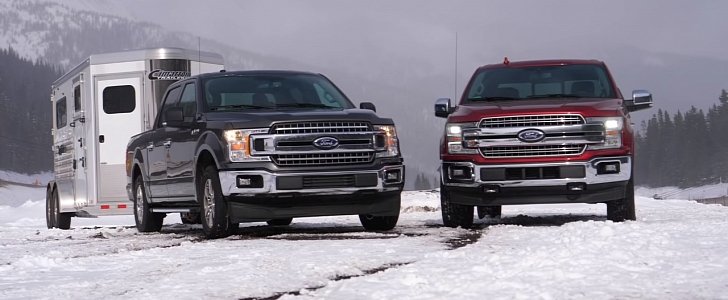EcoBoost has been introduced in 2009 in collaboration with the Germans at FEV Engineering and Mazda. Even Volvo used the 1.6- and 2.0-liter four-cylinder engine options, but Ford took a different approach with the twin-turbocharged 3.5-liter V6.
The twelfth generation of the F-150 received this engine, thanks in part to the shelving of the Ranger mid-size pickup for North America. From early 2011 to the present day, the EcoBoost with the largest displacement has been taken up to 450 horsepower in the F-150 Raptor and 647 horsepower in the GT mid-engine supercar.
Shelby is back for 2020 with the GT500, packing more than 700 horsepower. But even though this Mustang serves as the most powerful production vehicle from the Ford Motor Company, EcoBoost soldiers on as the golden standard for efficiency and performance.
The question is, does the 3.5-liter EcoBoost V6 fare better than the 5.0-liter Coyote V8 when it comes down to towing? TFLTruck took two F-150s “on the world’s toughest towing test,” and the verdict is a mixed bag. For starters, the EcoBoost is 4WD and features the 3:55 rear axle while the V8 is 2WD and comes with the taller 3:15 ratio.
Both trucks are equipped with the 10R80 automatic transmission, but torque favors the EcoBoost (470 pound-feet compared to 400 pound-feet). While towing a trailer at 60 mph with 8,900 pounds worth of water tanks up and down a stretch of highway that peaks at 11,158 feet, the V8 used less fuel while the V6 pulled through the gears better thanks to the twin-turbo setup making the most out of the available air.
A YouTube commenter hits the nail on the head, claiming “the axle ratio difference and 4x4 vs 4x2 make this pointless.” Another one highlights that “every single time they do this test with the Coyote they always give it some kind of disadvantage just to promote the V6.”
The thing is, there are no apples and oranges in the automotive world, no black and white. Instead, we’re dealing with shades of grey. Given these circumstances, the EcoBoost is better for some people while the V8 remains the preferred choice of others in the market for an F-150.
There’s more to a truck than numbers on paper. Like the superior reliability of the Coyote or the excess carbon build-up on the valves of the EcoBoost in pre-2018 models. The 2018 mid-cycle refresh improved on the design by combining port and direct injection.
Shelby is back for 2020 with the GT500, packing more than 700 horsepower. But even though this Mustang serves as the most powerful production vehicle from the Ford Motor Company, EcoBoost soldiers on as the golden standard for efficiency and performance.
The question is, does the 3.5-liter EcoBoost V6 fare better than the 5.0-liter Coyote V8 when it comes down to towing? TFLTruck took two F-150s “on the world’s toughest towing test,” and the verdict is a mixed bag. For starters, the EcoBoost is 4WD and features the 3:55 rear axle while the V8 is 2WD and comes with the taller 3:15 ratio.
Both trucks are equipped with the 10R80 automatic transmission, but torque favors the EcoBoost (470 pound-feet compared to 400 pound-feet). While towing a trailer at 60 mph with 8,900 pounds worth of water tanks up and down a stretch of highway that peaks at 11,158 feet, the V8 used less fuel while the V6 pulled through the gears better thanks to the twin-turbo setup making the most out of the available air.
A YouTube commenter hits the nail on the head, claiming “the axle ratio difference and 4x4 vs 4x2 make this pointless.” Another one highlights that “every single time they do this test with the Coyote they always give it some kind of disadvantage just to promote the V6.”
The thing is, there are no apples and oranges in the automotive world, no black and white. Instead, we’re dealing with shades of grey. Given these circumstances, the EcoBoost is better for some people while the V8 remains the preferred choice of others in the market for an F-150.
There’s more to a truck than numbers on paper. Like the superior reliability of the Coyote or the excess carbon build-up on the valves of the EcoBoost in pre-2018 models. The 2018 mid-cycle refresh improved on the design by combining port and direct injection.























